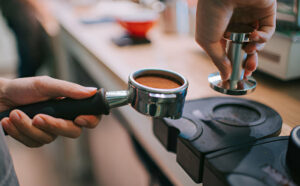-
Empty cart
No products in the cart.
Return to Shop

10 Must-Have Essentials for Perfect Espresso Coffee
Brewing the perfect espresso at home starts with having the right tools. Each piece of equipment plays a vital role in crafting a rich, flavorful

From barista competitions to your home brewing routine, the Weiss Distribution Technique (WDT) has become a key step in enhancing the quality of your espresso extraction.But how exactly should you use the WDT, and does it live up to the hype?
Let’s explore the ins and outs of utilizing the WDT for a better coffee experience.
WDT, also known as Weiss Distribution Technique or coffee acupuncture, involves stirring or poking the coffee grounds in the basket after adding them. This action breaks up clumps and ensures an even distribution of coffee grounds in the basket.
👉 Reduces channeling effects, providing a higher and more consistent extraction.
*Notes:* - WDT, named after John Weiss in 2005, originated to address excessive clumping in home coffee grinders. - Channeling occurs when water flows through the coffee grounds, choosing the path of least resistance, leading to uneven extraction.
Commercial coffee grinders were designed to break up large clumps and evenly distribute coffee grounds. Recently, with in-depth analyses of espresso machines like Decent, which allows variable flow/pressure extraction, WDT has regained popularity.
Scott Rao credits WDT for effective channeling reduction, leading to more uniform extraction and slightly slower extraction flow, indicating reduced channeling.
Examine the espresso extraction curve or observe the flow rate. Inconsistent or rapid flow suggests channeling. Bottomless portafilters can also reveal channeling.
👉 Increased resistance in the puck indicates a well-distributed coffee bed, a key feature of well-prepared coffee grounds.
*Example:* In flow-rate-dependent coffee machines, higher resistance means higher pressure within the puck. Decent Espresso's John Buckman noted, "Using WDT, we found that the extracted espresso has a higher peak pressure and lasts longer. This significantly enhances the quality of the extraction."
WDT focuses on flavor and consistency. Rao states that using WDT lowers the average bitterness and astringency, making extraction time and rate more consistent.
Choose the right tools; Barista Hustle recommends tools with a diameter greater than 1mm. Stir the coffee grounds evenly and carefully during the distribution process.
Scott Rao advises against excessive force during WDT, emphasizing uniform density.
*Applies to both manual and automatic tools.*
Barista Hustle’s white paper suggests that deep WDT is more effective than surface stirring in increasing overall puck resistance.
Jonathan found that the method of poking to the bottom could overall increase the resistance of the coffee puck, and the differences in resistance values between each extraction were relatively small.
👉 Deep WDT is more effective than puck raking.
Achieving manual consistency is challenging, leading to product upgrades from manual to automatic WDT tools to minimize variations.
Yes, WDT principles apply to pour-over. During the distribution phase, WDT can be used to relax the coffee bed, ensuring even saturation and facilitating a quicker and more uniform extraction during the bloom phase.
*Wet WDT, as tested by Barista Hustle:*
1. Inject the initial bloom water gently.
2. Draw a circle around the coffee bed’s outer edge and another within the inner edge.
3. Conclude with a gentle shake.
Observations:
👉 Wet WDT effectively releases trapped gases, improving color consistency and reducing visible bubbles during brewing.
👉 Significant increase in extraction rate without a substantial increase in water-coffee contact time.
👉 Enhanced coffee flavor with higher sweetness, deeper flavor layers, and a cleaner aftertaste.
Mastering the WDT opens up new possibilities for elevating your coffee experience, whether with espresso or alternative brewing methods.

Brewing the perfect espresso at home starts with having the right tools. Each piece of equipment plays a vital role in crafting a rich, flavorful

Hey there, fellow coffee aficionados! Have you ever witnessed the mesmerizing dance of espresso flowing freely from a bottomless portafilter? If not, prepare to be

If you’ve ever made espresso, you’ve probably heard the tip to press the coffee powder hard with a coffee tamper to ensure a good extraction.

What You Should and Shouldn’t Know About Cold Brew and Caffeine. What is Cold Brew Coffee? You’re probably familiar with cold brew coffee
Copyright 2024 © All rights Reserved. Design by EspressoFree

How can we help you?